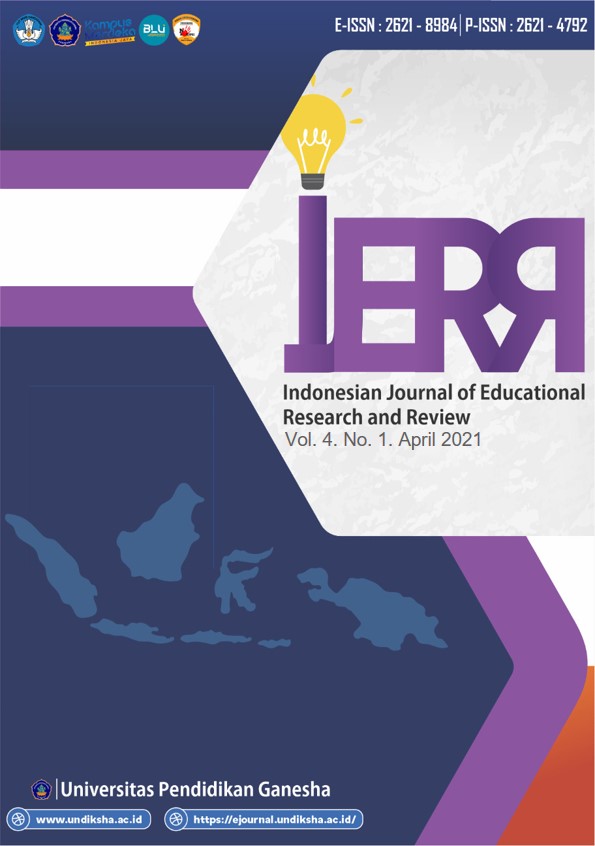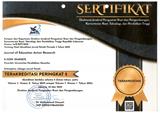(Mobile Assisted Language Learning) MALL Implementation During Distance Learning
DOI:
https://doi.org/10.23887/ijerr.v4i1.37302Keywords:
MALL, Remote Learning, APKCG, RASE Learning Design FrameworkAbstract
The rules for studying from home have been implemented since the outbreak of the Corona Virus. This impacts the education sector in Indonesia, which makes the government make regulations to learn from home—in addition, making the teaching and learning process held in the context of distance learning. This study aims to analyze the learning process that applies MALL during the distance learning process and the challenges during education. The instruments used to obtain the data were self-rated questionnaires, observation checklists, and interview guidelines. This instrument was developed from the Prospective Teacher Ability Assessment Tool (APKCG) and the RASE learning design framework. The technique used to analyze the data is descriptive qualitative analysis. This study indicates that English teachers have implemented MALL during the distance learning process by using several online platforms as classrooms in their activities. Several challenges arise from teachers and students in this learning process, including the lack of teacher ability in utilizing technology, unsupported student devices, and unstable student connections.
References
Abidah, A., Hidaayatullaah, H. N., Simamora, R. M., Fehabutar, D., & Mutakinati, L. (2020). The Impact of Covid-19 to Indonesian Education and Its Relation to the Philosophy of “Merdeka Belajar.” Studies in Philosophy of Science and Education, 1(1), 38–49. https://doi.org/https://doi.org/10.46627/sipose.v1i1.9.
Ariebowo, T. (2021). Autonomous learning during COVID-19 pandemic : Students ’ objectives and preferences. Journal of Foreign Language Teaching and Learning, 6(1), 56–77. https://doi.org/https://doi.org/10.18196/ftl.v6i1.10079.
Arifuddin, Suwatra, & Mahadewi. (2020). Pengembangan Konten E-learning Berorientasi Pendidikan Karakter Pada Mata Pelajaran Seni Budaya. Jurnal Edutech Undiksha, 8(2). https://doi.org/http://dx.doi.org/10.23887/jeu.v8i2.28942.
Atmojo, A. E. P., & Nugroho, A. (2020). EFL classes must go online! Teaching activities and challenges during COVID-19 pandemic in Indonesia. Register Journal, 13(1), 49–76. https://doi.org/https://doi.org/10.18326/rgt.v13i1.49-76.
Ayuni, D., Marini, T., Fauziddin, M., & Pahrul, Y. (2021). Kesiapan Guru TK Menghadapi Pembelajaran Daring Masa Pandemi Covid-19. Jurnal Obsesi : Jurnal Pendidikan Anak Usia Dini, 5(1). https://doi.org/https://doi.org/10.31004/obsesi.v5i1.579.
Azar, A. S., & Nasiri, H. (2014). Learners’ Attitudes toward the Effectiveness of Mobile Assisted Language Learning (MALL) in L2 Listening Comprehension. Procedia - Social and Behavioral Sciences, 98. https://doi.org/https://doi.org/10.1016/j.sbspro.2014.03.613.
Bhuana, G. P., & Apriliyanti, D. L. (2020). Teachers’ Encounter of Online Learning: Challenges and Support System. 5(52), 147–158.
Cecep, Mutaqin, & Pamungkas. (2019). Pengembangan Modul Quick Math Berbasis Mobile Learning sebagai Penunjang Pembelajaran Matematika di SMA. Prisma Sains: Jurnal Pengkajian Ilmu Dan Pembelajaran Matematika Dan IPA IKIP Mataram, 7(2). https://doi.org/https://doi.org/10.33394/j-ps.v0i0.1761.
Chen, C.-H., & Tsai, C.-C. (2021). In-service teachers’ conceptions of mobile technology-integrated instruction: Tendency towards student-centered learning. Computers & Education, 170(1). https://doi.org/https://doi.org/10.1016/j.compedu.2021.104224.
Chen, Y., Mayall, H. J., York, C. S., & Smith, T. J. (2019). Parental perception and English Learners’ mobile-assisted language learning: An ethnographic case study from a technology-based Funds of Knowledge approach. Learning, Culture and Social Interaction, 22. https://doi.org/https://doi.org/10.1016/j.lcsi.2019.100325.
Churchill, D., King, M., & Fox, B. (2013). Learning design for science education in the 21st century. Zbornik Instituta Za Pedagoska Istrazivanja, 45(2), 404–421. https://doi.org/10.2298/ZIPI1302404C.
Churchill, D., King, M., & Fox, B. (2016). Framework for Designing Mobile Learning Environments Daniel. Mobile Learning Design: Theories and Application, 3–22. https://doi.org/10.1007/978-981-10-0027-0.
Dashtestani, R. (2013). Implementing mobile-assisted language learning (MALL) in an EFL context: Iranian EFL teachers’ perspectives on challenges and affordances. The JALT CALL Journal, 9(2), 149–168. https://doi.org/10.29140/jaltcall.v9n2.153.
Dewi, A., Ningrum, H., & Arrasyid, F. I. (2021). Students ’ Perceptions Towards The Implementation Of Mall In English Learning : A Case In Senior High School. 2(1), 21–32. https://doi.org/10.22236/ellter.v2i1.6243.
Ferri, F., Grifoni, P., & Guzzo, T. (2020). Online Learning and Emergency Remote Teaching: Opportunities and Challenges in Emergency Situations. Societies, 10(4), 86. https://doi.org/10.3390/soc10040086.
Fitriyani, Y., Fauzi, I., & Sari, M. Z. (2020). Motivasi Belajar Mahasiswa Pada Pembelajaran Daring Selama Pandemik Covid-19. Profesi Pendidikan Dasar, 7(1), 121–132. https://doi.org/10.23917/ppd.v7i1.10973.
Fund, U. N. C. (2020). COVID-19 and Children in Indonesia. COVID-19 and Children in Indonesia, (11 May).
Gafur, A. (2012). Desain Pembelajaran Konsep, Model, dan Aplikasinya dalam Perencanaan Pelaksanaan Pembelajaran. Yogyakarta: Penerbit Ombak.
Gay, L. R., Mills, G. E., & Airasian, P. W. (2012). Educational Research: Competencies for Analysis and Application.
Geng, S., Law, K. M. Y., & Niu, B. (2019). Investigating self-directed learning and technology readiness in blending learning environment. International Journal of Educational Technology in Higher Education, 16(1), 17. https://doi.org/10.1186/s41239-019-0147-0.
Gunarta, I. G. (2018). Pengaruh Model Pembelajaran TGT Berbantuan Media Question Card Terhadap Hasil Belajar IPA. Jurnal Pedagogi Dan Pembelajaran, 1(2). https://doi.org/http://dx.doi.org/10.23887/jp2.v1i2.19338.
Hou, Z., & Aryadoust, V. (2021). A review of the methodological quality of quantitative mobile-assisted language learning research. System, 100. https://doi.org/https://doi.org/10.1016/j.system.2021.102568.
IG, B., G, M., & TL, T. (2019). Universitas Pendidikan Ganesha. Jurnal IKA, 17(2), 171. https://doi.org/10.23887/ika.v17i2.19853.
Irni, Sumarni, & Saraswati. (2017). Pengembangan Media Pembelajaran Mobile Learning Berbasis Android. Jurnal Penelitian & Pengembangan Pendidikan Fisika, 3(1), 59. https://doi.org/10.21009/jrpk.072.10.
Irwanto, Taufik, Hernawan, & Rizal. (2019). Efektivitas Multimedia Interaktif Dan Mobile Learning Dalam Meningkatkan Hasil Belajar Siswa Pada Mata Pelajaran Seni Budaya. Jurnal Pendidikan Dan Kajian Seni, 4(1). https://doi.org/http://dx.doi.org/10.30870/jpks.v4i1.6845.
Kurtz, G., Tsimerman, A., & Steiner, O. (2014). The Flipped Classroom Answer to Future Learning? European Journal of Open, Distance and E-Learning, 17(2). https://doi.org/https://doi.org/10.2478/eurodl-2014-0027.
Liu, C., He, J., Ding, C., Fan, X., Hwang, G.-J., & Zhang, Y. (2021). Self-oriented learning perfectionism and English learning burnout among EFL learners .using mobile applications: The mediating roles of English learning anxiety and grit. Learning and Individual Differences, 88. https://doi.org/https://doi.org/10.1016/j.lindif.2021.102011.
Liu, G. Z., Lu, H. C., & Lai, C. T. (2016). Towards the construction of a field: The developments and implications of mobile assisted language learning (MALL). Digital Scholarship in the Humanities, 31(1), 164–180. https://doi.org/10.1093/llc/fqu070.
Masyithah, H., Muchtar, Z., & Mahmud. (2015). Pengaruh Penerapan Multimedia Camtasia Studio dan Media Power Point terhadap Aktivitas dan Hasil Belajar Siswa pada Materi Struktur Atom. Jurnal Pelangi Pendidikan, 8(2). https://doi.org/https://doi.org/10.24114/pelangi.v22i2.6217.
Miles, M. B., Huberman, A. M., & Saldana, J. (2014). Qualitative Data Analysis.
Muswita, Utomo, A. B., Yelianti, U., & Wicaksana, E. J. (2018). Pengembangan E-Book Berbasis Mobile Learning Pada Mata Kuliah Struktur Tumbuhan. Pendidikan Biologi, 11, 93–104. https://doi.org/https://doi.org/10.20961/bioedukasi-uns.v11i2.23814.
Ngabekti, Prasetyo, Hardianti, & Teampanpong. (2019). The Development of STEM Mobile Learning Package Ekosistem. Jurnal Pendidikan IPA Indonesia, 8(1), 81–88. https://doi.org/https://doi.org/10.15294/jpii.v8i1.16905.
Noviar, D. (2016). Pengembangan Ensiklopedi Biologi Mobile Berbasis Android Materi Pokok Pteridophyta Dalam Rangka Implementasi Kurikulum 2013. Cakrawala Pendidikan, 35(2). https://doi.org/https://doi.org/10.21831/cp.v15i2.8255.
Nugroho, A., Ilmiani, D., & Rekha, A. (2021). EFL Teachers’ Challenges and Insights of Online Teaching amidst Global Pandemic. Metathesis: Journal of English Language, Literature, and Teaching, 4(3), 277. https://doi.org/10.31002/metathesis.v4i3.3195.
Nursyam, A. (2019). Peningkatan Minat Belajar Siswa Melalui Media Pembelajaran Berbasis Teknologi Informasi. Jurnal Penelitian Hukum Dan Pendidikan, 18(1), 811–819. https://doi.org/http://dx.doi.org/10.30863/ekspose.v18i1.371.
Pratama, F., Firman, & Neviyarni. (2019). Pengaruh Motivasi Belajar IPA Siswa Terhadap Hasil Belajar Di Sekolah Dasar Negeri 01. Jurnal Ilmu Pendidikan, 1(3), 280–286. https://doi.org/https://doi.org/10.31004/edukatif.v1i3.63.
Pratiwi, I., Suartama, I. K., & Tegeh, I. M. (2016). Pengembangan E-Learning dengan Model Prototype Berorientasi Model Pembelajaran Inquiry Siswa Kelas VII SMPN 2 Negara. Jurnal Edutech Undiksha, 4(2). https://doi.org/http://dx.doi.org/10.23887/jeu.v4i2.7615.
Puspita, L. (2019). Pengembangan Modul Berbasis Keterampilan Proses Sains Sebagai Bahan Ajar Dalam Pembelajaran Biologi. Jurnal Inovasi Pendidikan IPA, 5(1), 79–87. https://doi.org/https://doi.org/10.21831/jipi.v5i1.22530.
Putri, E. N. D., & Desyandari. (2019). Penggunaan Media Lagu Dalam Pembelajaran Tematik di Sekolah Dasar. Jurnal Ilmu Pendidikan, 1(3), 233–236. https://doi.org/https://doi.org/10.31004/edukatif.v1i3.52.
Rosalina, E., Nasrullah, & Elyani, E. P. (2020). LET : Linguistics , Literature and English Teaching Journal The Analysis Of Difficulties. 9(2), 112–132.
Saragih, E. E., & Jaelani, A. (2020). Implementing Mobile-Assisted Language Learning (MALL) in Writing Classroom: Pre-service Teacher’s Opinions. Prosiding Lppm Uika Bogor, 24–33.
Segaran, K., Ali, A. Z. M., & Hoe, T. W. (2014). Usability and User Satisfaction of 3D Talking-head Mobile Assisted Language Learning (MALL) App for Non-native Speakers. Procedia - Social and Behavioral Sciences, 131. https://doi.org/https://doi.org/10.1016/j.sbspro.2014.04.069.
Solehana, L., Asrori, A., & Usman, A. (2019). The Development of E-Learning Teaching Material Based on Edmodo on Basic Competencies of National Integration at Class X of Senior High School. Journal Of Education, Teaching And Learning, 4(2). https://doi.org/https://doi.org/10.26737/jetl.v4i2.1914.
Soleimani, E., Ismail, K., & Mustaffa, R. (2014). The Acceptance of Mobile Assisted Language Learning (MALL) among Post Graduate ESL Students in UKM. Procedia - Social and .Behavioral Sciences, 118. https://doi.org/https://doi.org/10.1016/j.sbspro.2014.02.062.
Sunismi. (2015). Developing Guided Discovery Learning Materials Using Mathematics Mobile Learning Application As An Alternative Media For The Students Calculus II. Cakrawala Pendidikan, 34(5). https://doi.org/https://doi.org/10.21831/cp.v3i3.7340.
Suryanda, Ernawati, & Maulana. (2016). Pengembangan Modul Multimedia Mobile Learning Dengan Android Studio 4.1 Materi Keanekaragaman Hayati Bagi Siswa Sma Kelas X. Jurnal Pendidikan Biologi, 9(1), 55–64. https://doi.org/https://doi.org/10.21009/biosferjpb.9-1.9.
Tafonao, T. (2018). Peranan Media Pembelajaran Dalam Meningkatkan Minat Belajar Mahasiswa. Jurnal Komunikasi Pendidikan, 2(2), 1–13. https://doi.org/https://doi.org/10.32585/jkp.v2i2.113.
Wahyono, P., Husamah, H., & Budi, A. S. (2020). Guru profesional di masa pandemi COVID-19: Review implementasi, tantangan, dan solusi pembelajaran daring. Jurnal Pendidikan Profesi Guru, 1(1), 51–65. https://doi.org/https://doi.org/10.22219/jppg.v1i1.12462.
Wahyu, H., Cholis, N., Fauziati, E., & Supriyadi, S. (2018). the Implementation of Mall in Reading Comprehension : Students ’ Perspectives. The International English Language Teachers and Lecturers Conference (INELTAL), 36–42.
Warsita, B. (2017). Peran dan Tantangan Profesi Pengembang Teknologi Pembelajaran Pada Pembelajaran Abad 21. Kwangsan: Jurnal Teknologi Pendidikan, 5(2). https://doi.org/https://doi.org/10.31800/jtp.kw.v5n2.p77--90.
Wulandari, H., & Purwanta, E. (2021). Pencapaian Perkembangan Anak Usia Dini di Taman Kanak-kanak selama Pembelajaran Daring di Masa Pandemi Covid-19. Jurnal Obsesi : Jurnal Pendidikan Anak Usia Dini, 5(1). https://doi.org/https://doi.org/10.31004/obsesi.v5i1.626.
Wulandari, Sudatha, & Simamora. (2020). Pengembangan Pembelajaran Blended Pada Mata Kuliah Ahara Yoga Semester II di IHDN Denpasar. Jurnal Edutech Undiksha, 8(1), 1–15. https://doi.org/http://dx.doi.org/10.23887/jeu.v8i1.26459.
Yudhiantara, R. A., & Saehu, A. (2017). Mobile-Assisted Language Learning (MALL) in Indonesian Islamic Higher Education. IJELTAL (Indonesian Journal of English Language Teaching and Applied Linguistics), 2(1), 21–31. https://doi.org/10.21093/ijeltal.v2i1.52.
Yulisari, S. (2013). Pengaruh Model Pembelajaran Vct Berbantuan Media Power Point Terhadap Hasil Belajar Pkn Siswa Kelas V Sd Gugus V Kecamatan Buleleng. Mimbar PGSD Undiksha, 1(1). https://doi.org/http://dx.doi.org/10.23887/jjpgsd.v1i1.719.
Downloads
Published
How to Cite
Issue
Section
License
Authors who publish with the Indonesian Journal of Educational Research and Review (IJERR) agree to the following terms:
- Authors retain copyright and grant the journal the right of first publication with the work simultaneously licensed under a Creative Commons Attribution License (CC BY-SA 4.0) that allows others to share the work with an acknowledgment of the work's authorship and initial publication in this journal.
- Authors are able to enter into separate, additional contractual arrangements for the non-exclusive distribution of the journal's published version of the work (e.g., post it to an institutional repository or publish it in a book), with an acknowledgment of its initial publication in this journal.
- Authors are permitted and encouraged to post their work online (e.g., in institutional repositories or on their website) prior to and during the submission process, as it can lead to productive exchanges, as well as earlier and greater citation of published work. (See The Effect of Open Access)












